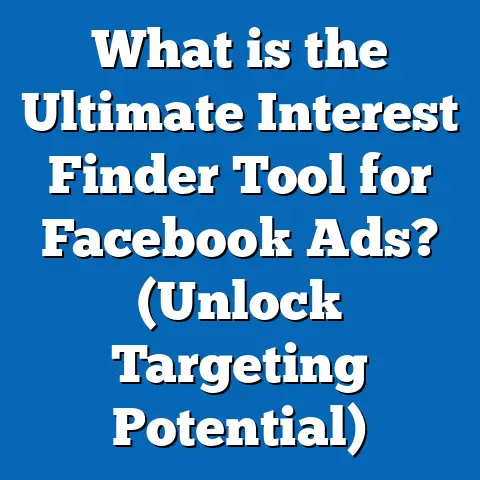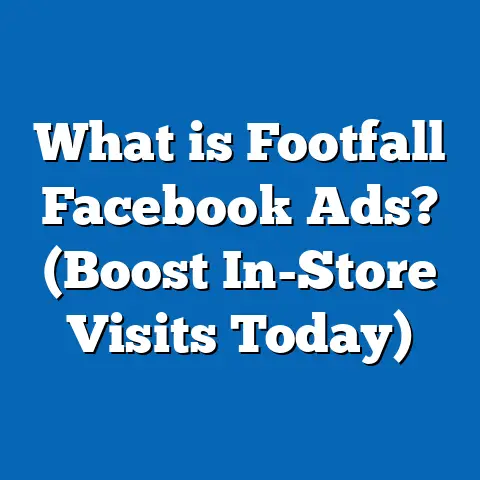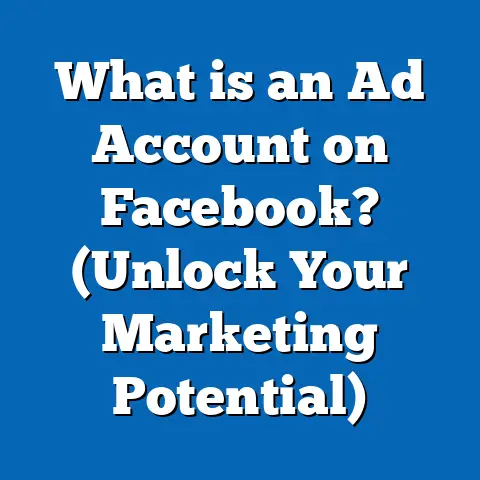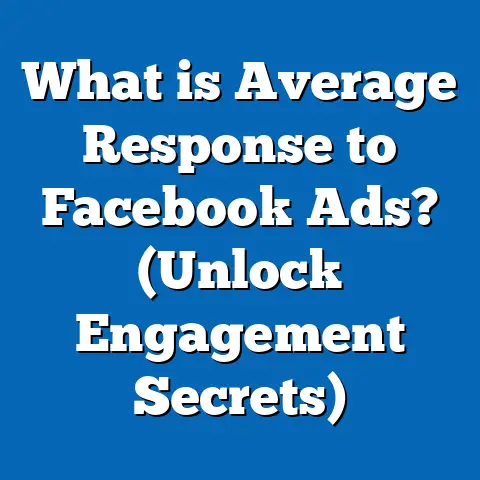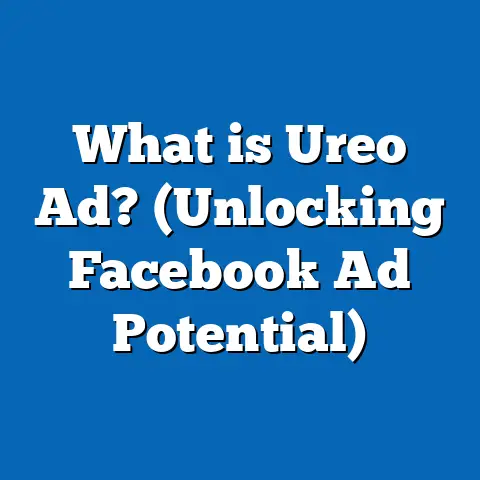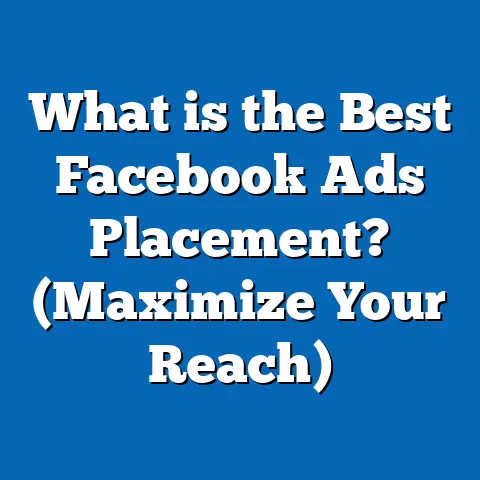What is a Promotion Objective in Facebook Ads? (Unlocking Success)
What is a Promotion Objective in Facebook Ads? (Unlocking Success)
Introduction: The Challenge of Effective Facebook Advertising
In the crowded digital marketplace of 2025, businesses face a critical challenge: How to break through the noise and reach the right audience effectively on Facebook. With over 3 billion monthly active users on Facebook and billions more on its associated platforms like Instagram and Messenger, the potential is enormous—but so is the complexity. Without a clear goal, advertising campaigns can become costly experiments with little return.
Marketers often invest heavily in Facebook Ads but struggle to see meaningful results because they don’t fully understand or leverage Promotion Objectives — the foundational choices that tell Facebook’s system exactly what you want to achieve. Unlocking this understanding can be the difference between wasted budget and successful growth.
This guide dives deep into what promotion objectives are, why they matter, how to choose the right one, and how to maximize your results using data-driven strategies.
Understanding Promotion Objectives in Facebook Ads
What is a Promotion Objective?
A Promotion Objective is the primary goal you set when creating a Facebook ad campaign. It directs Facebook’s smart delivery system (its algorithm) to optimize your ad placements and bidding strategy toward that goal.
Facebook’s ad platform offers a structured set of objectives tailored to different stages of the customer journey—from creating awareness to driving sales or leads. These objectives influence:
- Who sees your ads
- How often they see them
- What kind of actions they are nudged to take
Choosing the right objective helps ensure your ads are served to people most likely to take the desired action, improving efficiency and return on investment (ROI).
Why Are Promotion Objectives Important?
Without a clearly defined objective, Facebook’s algorithm cannot optimize ad delivery effectively. This often results in:
- Ads being shown to irrelevant audiences
- High costs per click (CPC) or acquisition (CPA)
- Low engagement rates
- Poor overall campaign performance
Data from Facebook Business shows that campaigns with well-defined objectives outperform those without by:
- Up to 37% higher conversion rates
- Around 25% lower cost per acquisition
- Increased ad recall and engagement metrics
Clearly defined objectives also help marketers measure success accurately and align campaigns with broader business goals.
How Facebook’s Algorithm Uses Promotion Objectives
Facebook’s advertising system leverages machine learning models trained on billions of user interactions. When you choose an objective, you’re telling Facebook what success looks like for your ad.
For example:
- If your objective is Conversions, Facebook shows your ads to users most likely to complete a purchase or form submission based on past behavior.
- If your objective is Traffic, it targets users more likely to click through to your website or app.
- For Brand Awareness, it optimizes for users who pay attention and remember ads.
This targeted optimization reduces wasted impressions and improves cost efficiency.
The Three Main Categories of Facebook Promotion Objectives
Facebook groups its promotion objectives under three primary categories that align with stages of the marketing funnel:
- Awareness
- Consideration
- Conversion
Each category supports different business goals and customer journey phases.
1. Awareness Objectives: Building Recognition and Recall
Brand Awareness Objective
Purpose:
Designed to increase recognition of your brand by showing your ads to people likely to remember them.
How it Works:
Facebook uses “Ad Recall Lift” modeling to identify users who are most likely to recall seeing your ad within two days.
Use Cases:
- Launching new products
- Building brand identity
- Entering new markets
Data Insight:
According to Facebook, brand awareness campaigns can improve ad recall by up to 20-30%, making this ideal for early funnel marketing.
Example:
A startup launching an eco-friendly water bottle runs brand awareness ads targeting health-conscious millennials. The campaign drives a significant uptick in brand recall surveys.
Reach Objective
Purpose:
Maximizes the number of unique people who see your ad within a set area or demographic.
How it Works:
Facebook delivers your ad to as many people as possible within your target audience, limiting frequency if specified.
Use Cases:
- Event promotions
- Broad announcements
- Public service campaigns
Data Point:
Campaigns optimized for reach can generate up to 50% more impressions than other objectives in local marketing.
Example:
A music festival organizer uses reach ads to inform residents across a city about an upcoming event, maximizing exposure.
2. Consideration Objectives: Driving Engagement and Interest
Traffic Objective
Purpose:
Drive users from Facebook to anywhere online—your website, app, or Messenger.
How it Works:
Facebook optimizes delivery for clicks on links embedded in the ad.
Use Cases:
- Blog post promotion
- Product landing pages
- App download pages
Data Insight:
Facebook reports that traffic campaigns optimized for link clicks generally have a CTR (click-through rate) 20% higher than non-optimized campaigns.
Example:
An online education platform promotes a free webinar landing page using traffic ads, resulting in a large increase in sign-ups.
Engagement Objective
Purpose:
Boost interaction with your content—likes, comments, shares, event responses.
How it Works:
Facebook targets users most likely to engage with posts based on historical activity.
Use Cases:
- Increasing social proof
- Growing community
- Event promotion
Real-world Application:
A restaurant uses engagement ads to promote customer testimonials and menu specials, building buzz and organic reach.
App Installs Objective
Purpose:
Encourage people to download and install your mobile app.
How it Works:
Facebook shows ads to users who are more apt to install apps based on past download behaviors.
Use Cases:
- New app launches
- Feature updates requiring re-downloads
Statistic:
App install campaigns optimized correctly see an average 15% lower cost per install compared to generic campaigns.
Example:
A fitness tracking app uses app install ads targeting health-conscious users on Instagram and Facebook stories, driving significant downloads.
Video Views Objective
Purpose:
Maximize views on video content.
How it Works:
Facebook optimizes delivery for users likely to watch videos for longer durations.
Use Cases:
- Product demos
- Brand storytelling
- Tutorials
Insight:
Video ads optimized for views have been shown to increase engagement by up to 40% compared with static image ads.
Example:
A beauty brand creates tutorial videos and promotes them using video view objectives, leading to increased followers and website visits.
Lead Generation Objective
Purpose:
Collect leads directly within Facebook using forms pre-filled with user data.
How it Works:
Users fill out lead forms without leaving the platform, reducing friction.
Use Cases:
- Newsletter sign-ups
- Webinar registrations
- Free trials
Case Study:
A SaaS company switched from traffic campaigns to lead generation forms and increased leads by 50% while reducing cost per lead by 18%.
Messages Objective
Purpose:
Drive conversations via Messenger or WhatsApp with potential customers.
How it Works:
Optimizes ad delivery towards users likely to start messaging businesses.
Use Cases:
- Customer service automation with chatbots
- Direct sales conversations
- Personalized offers
3. Conversion Objectives: Driving Sales and Actions
Conversions Objective
Purpose:
Encourage specific customer actions like purchases, sign-ups, or downloads on your website or app.
How it Works:
Requires installation of Facebook Pixel or SDK for tracking conversions accurately. Optimizes delivery based on users likely to convert.
Data Insight:
Conversion campaigns show an average 35% higher purchase rate than non-conversion optimized campaigns when pixel data is leveraged properly.
Example:
An online retailer uses conversion objectives combined with retargeting ads, improving sales by 28% and reducing cost per purchase by 22%.
Catalog Sales Objective
Purpose:
Promote products dynamically from an online catalog tailored to user behavior.
How it Works:
Uses product feeds to automatically show relevant items based on browsing history or interests.
Use Cases:
- E-commerce stores with large product ranges
- Personalized retargeting campaigns
Impact Example:
Retailers using catalog sales objectives report revenue gains of up to 25% from retargeting efforts alone.
Store Traffic Objective
Purpose:
Drive foot traffic to physical store locations using location-based targeting.
How it Works:
Targets users near store locations with ads designed to encourage visits.
Use Cases:
- Local retailers
- Restaurants
- Service providers with physical locations
Statistic:
Retailers report up to a 15% increase in foot traffic after running store traffic campaigns consistently.
Deep Dive: Technical Aspects of Setting Promotion Objectives
Installing and Using Facebook Pixel for Conversion Tracking
The Facebook Pixel is a small snippet of code added to your website that tracks user behavior such as page views, add-to-cart events, purchases, and more. It enables:
- Accurate measurement of conversion objectives
- Building custom audiences based on site activity
- Retargeting visitors who didn’t convert initially
Pro Tip: Advanced marketers use pixel event tracking combined with custom conversions for highly granular optimization.
Using SDK for Mobile App Campaigns
For app install and engagement objectives, integrating Facebook SDK allows tracking installs and in-app events like purchases or level completions. This data feeds into campaign optimization algorithms for better targeting.
Practical Examples: Matching Business Goals With Promotion Objectives
| Business Type | Goal | Recommended Promotion Objective(s) | Key Tips |
|---|---|---|---|
| New Startup | Build brand awareness | Brand Awareness | Focus on broad targeting; test creative variants |
| E-commerce Store | Increase online sales | Conversions, Catalog Sales | Use pixel; retarget cart abandoners |
| SaaS Company | Generate leads | Lead Generation | Use pre-filled forms; offer strong CTAs |
| Local Restaurant | Drive foot traffic | Store Traffic | Use geo-targeting; time ads around peak hours |
| Mobile App Developer | Boost app installs | App Installs | Optimize for mobile placements; use SDK |
Comparing Facebook Promotion Objectives With Other Platforms
| Platform | Strengths | Key Objective Types | When To Choose |
|---|---|---|---|
| Facebook Ads | Advanced targeting; multi-objective funnel | Awareness, Consideration, Conversion | Broad audience reach; multi-stage funnel marketing |
| Google Ads | Search intent; keyword targeting | Sales, Leads, Website Traffic | When capturing high-intent search traffic |
| LinkedIn Ads | B2B professional targeting | Brand Awareness, Lead Gen | B2B lead generation; professional services marketing |
| TikTok Ads | Young audience; video engagement | Traffic, Conversions | Viral short-form video content marketing |
Each platform has unique strengths and audience types; integrating multiple platforms often yields best results.
Latest Trends & Innovations in Facebook Promotion Objectives (2024–2025)
AI-Powered Campaign Objectives
Facebook has introduced AI-driven automated campaign objectives that dynamically adjust based on real-time performance data. This can:
- Optimize budgets across multiple ad sets automatically
- Shift focus between awareness and conversion based on market conditions
- Reduce manual campaign management time by up to 40%
Integration With Facebook Shops & Commerce Features
The growth of Facebook Shops means catalog sales objectives are now tightly integrated with e-commerce storefronts inside Facebook and Instagram, offering:
- Seamless shopping experiences without leaving the platform
- Improved product recommendations through AI
- Real-time inventory syncing for dynamic ads
Focus on Engagement Quality Metrics
Beyond clicks and impressions, newer metrics measure engagement quality—how long users spend interacting with content or repeat engagements—helping advertisers better understand true audience interest.
Advanced Strategies for Maximizing Promotion Objective Success
1. Funnel-Based Campaign Structuring
Map promotion objectives along the customer journey:
| Stage | Objective Category | Campaign Focus |
|---|---|---|
| Awareness | Awareness | Brand recognition |
| Consideration | Consideration | Driving interest & leads |
| Conversion | Conversion | Closing sales & actions |
Running separate campaigns for each stage ensures relevant messaging and optimized budget allocation.
2. Layered Audience Targeting & Retargeting
Use custom audiences built from pixel data combined with lookalike audiences for prospecting. Retarget users based on:
- Website visits
- Cart abandonment
- Past purchases
This layered approach improves conversion rates substantially.
3. Creative Testing & Optimization by Objective
Match creatives with objectives:
- Awareness: Storytelling videos & brand-centric images
- Consideration: Detailed product demos & testimonials
- Conversion: Clear CTAs & limited-time offers
Test multiple variants regularly using split tests (A/B testing) for continuous improvement.
4. Budget Allocation Based on Objective Performance
Analyze performance metrics such as Cost Per Result (CPR), Return On Ad Spend (ROAS), and adjust budgets weekly:
- Sales grew by 28%
- Cost per purchase dropped by 22%
- ROAS improved from 3:1 to 5:1
They combined catalog sales with retargeting dynamic ads showing personalized product recommendations based on user behavior.
Case Study 2: SaaS Company Increases Leads Using Lead Generation Ads
A software company aiming for webinar registrations switched from traffic campaigns directing users off-platform to lead gen forms within Facebook:
- Lead volume increased by 50%
- Cost per lead decreased by 18%
The pre-filled forms reduced friction and increased form completion rates dramatically compared to external landing pages.
Case Study 3: Local Restaurant Drives Foot Traffic With Store Traffic Ads
A restaurant chain launched geo-targeted store traffic campaigns:
- Foot traffic increased by 15%
- Customer visits during lunch hours rose by 20%
Targeting was refined using location radius filters and time-based scheduling aligned with meal times for maximum impact.
Measuring Success: Important Metrics by Promotion Objective
| Objective | Key Metrics | What They Indicate |
|---|---|---|
| Brand Awareness | Ad Recall Lift, Impressions | Brand visibility & memorability |
| Reach | Unique Reach, Frequency | Audience size & exposure frequency |
| Traffic | Click-through Rate (CTR), CPC | Effectiveness driving site visits |
| Engagement | Likes, Shares, Comments | User interaction & social proof |
| App Installs | Install Volume, Cost per Install | App acquisition efficiency |
| Video Views | Video Average Watch Time | Content engagement quality |
| Lead Generation | Leads Generated, Cost per Lead | Effectiveness capturing prospects |
| Conversions | Conversion Rate, CPA | Success driving business actions |
| Catalog Sales | ROAS, Revenue | Revenue from dynamic product ads |
| Store Traffic | Store Visits | Physical footfall increase |
Using these metrics consistently ensures clear understanding of campaign performance relative to objectives.
Common Mistakes When Choosing Promotion Objectives and How To Avoid Them
- Not Aligning Objectives With Business Goals Running conversion campaigns without having tracking pixels installed can lead to wasted budget. Fix: Ensure pixel setup before launching conversion-focused ads.
- Choosing Broad Objectives Without Testing Using only awareness or reach objectives when you want direct sales reduces efficiency. Fix: Test multiple objectives in small budgets before scaling.
- Ignoring Funnel Stages Treating all audiences the same regardless of where they are in their journey reduces effectiveness. Fix: Create segmented campaigns tailored by funnel phase — awareness vs conversion.
- Neglecting Creative Alignment Using hard-sell creatives in awareness campaigns can deter early-stage prospects. Fix: Match creative styles with objective goals.
- Not Monitoring or Adjusting Campaigns Letting campaigns run without ongoing analysis wastes money and opportunities. Fix: Set regular review schedules (weekly or bi-weekly) for optimization decisions.
Conclusion: Unlocking Success With Promotion Objectives in Facebook Ads
Promotion Objectives are not just an optional setting—they are the backbone of every successful Facebook advertising campaign. They tell Facebook what matters most in your campaign and shape how your budget is spent toward real business results.
By understanding each objective’s purpose, aligning them with your specific business goals, leveraging data-driven tools like Facebook Pixel, and continuously optimizing based on performance metrics, marketers can transform their advertising efforts from guesswork into a strategic engine for growth.
Remember: The right promotion objective combined with smart targeting, compelling creative, and ongoing testing will unlock success in your Facebook advertising efforts—turning clicks into customers consistently.
Next Steps: Action Plan For Marketers & Business Owners
- Review current campaigns — Are their promotion objectives aligned with business goals?
- Implement or audit Facebook Pixel installation for accurate conversion tracking.
- Define clear funnel stages and assign appropriate promotion objectives per campaign.
- Develop creative assets matching each objective’s intent.
- Launch A/B tests comparing different objectives for key products/services.
- Monitor key metrics regularly; adjust budgets based on performance.
- Stay updated on new features like AI-powered objectives or commerce integrations.
- Consider cross-platform advertising strategies incorporating Google or LinkedIn where relevant.
- Document learnings and optimize iteratively—advertising success comes from continuous improvement.
If you want me to provide detailed templates for campaign setup or sample creatives tailored by promotion objective next, just let me know!

